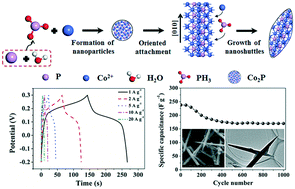Microwave-assisted hydrothermal synthesis of cobalt phosphide nanostructures for advanced supercapacitor electrodes
Abstract
Cobalt phosphide (Co2P) nanoshuttles were synthesized via simple microwave-assisted hydrothermal treatment of cobalt chloride and yellow phosphorus at 220 °C for 30 min. Their crystalline structure and morphology were characterized by scanning electron microscopy, transmission electron microscopy, X-ray diffraction, and X-ray photoelectron spectroscopy. The as-prepared nanoshuttles were ∼20 μm long, and their diameter decreased from about 300 nm in the central part to <30 nm at their terminal tips. A combined oriented attachment and Ostwald ripening mechanism is proposed for the Co2P nanoshuttle formation, based on the experimental results and density functional theory calculations. The as-prepared Co2P nanoshuttles exhibited excellent electrochemical properties, e.g., a specific capacitance of 246 F g−1 at a discharge current density of 1 A g−1 along with excellent cycling stability, suggesting their great application potential in high-performance energy storage/conversion devices.



 Please wait while we load your content...
Please wait while we load your content...